Mealtime Partners, Inc.
Specializing in Assistive Dining and Drinking Equipment
August 2017 Independent Eating and Drinking Newsletter

|
August Topics:
|
||
|
Mealtime Partners Home Page Send a Comment or Suggestion |
|||
| Subscribe to Newsletters |
Special Services Available for Children
Now that children are starting, or heading back to school, it is time for a brief overview of the services that are available to those who have disabilities. The first half of this article will provide a summary of the laws that govern service provision for children who have disabilities. The second part provides a discussion of how to develop a meaningful Individualized Education Program (IEP) for students who have significant developmental delays and may benefit from the use of assistive technology to achieve meaningful IEP goals.
In 1975, President Gerald Ford signed The Education for All Handicapped Children Act, now known as The Individuals with Disabilities Education Act (IDEA). IDEA is a law that mandates that a free appropriate public education is made available to children with disabilities throughout the United States. Part B of the law covers children aged 3 through 21 ensuring that they receive educational and related services. The law secures access to a free appropriate public education (FAPE) in the least restrictive environment (LRE) to every child with a disability. Part C of the law includes early intervention services for infants, from birth through age 2 who have disabilities. The Department of Education has a website that provides a plethora of information about IDEA: https://sites.ed.gov/idea/about-idea/.
Each state is responsible for the administration of the law, and the services provided vary from state to state. The following link shows a chart of the States’ and territories’ definitions of criteria for IDEA Part C eligibility: http://www.nectac.org/~pdfs/topics/earlyid/partc_elig_table.pdf.
Infants are eligible for intervention services through IDEA, Part C, if they are identified with developmental delays in one or more of the following areas: cognitive development, physical development, communication development, social or emotional development, or adaptive development; or, have a diagnosed physical or mental condition that has a high probability of resulting in developmental delay. A multidisciplinary evaluation of the child to identify the needs of the child, will establish his/her eligibility to receive services, and identify the needed services, through the states Early Intervention Program. Once the child is found to be eligible for intervention services, a team including the parents and professionals who will provide services, and a service coordinator, meet to develop the Individualized Family Service Plan (IFSP). This written plan is an important document; it describes the early intervention services that will be provided to the child and family. These services continue until the child reaches age 3, at which time early intervention services are discontinued and the child transitions into the school system.
As stated in the beginning of this article, the goal of the Individuals with Disabilities Education Act is to ensure that all children with disabilities have available to them a free appropriate public education that meets their unique needs and prepares them for further education, employment, and independent living. IDEA states that services should be provided to enable children to function in regular education classes, and in extracurricular and nonacademic settings, and to enable children with disabilities to be educated with nondisabled children to the maximum extent appropriate. To define how this will be accomplished an Individualized Education Program (IEP) is developed for each public school child who needs special education. The IEP is created through a team effort (including parents) and is reviewed periodically. It sets out specific goals and how the goals will be measured for each domain in which services are being provided.
It is important to include functional IEP goals for students with disabilities. Functional refers to nonacademic activities, as in “routine activities of everyday living.” The purpose of the IEP is to prepare students with disabilities for life after school. Schools should understand that for some children, teaching them how to "function" in the world is as important as teaching academic skills. IDEA requires that regardless of whether the ultimate goal of the IEP is to teach functional or academic skills, a functional performance statement must be included in the IEP documentation [IDEA Section 1414(d)(1)(A)(i)(I)].
Functional skills are defined as skills that will promote independence and exploration. Adaptability of the skills should be encouraged so that they can be used in multiple settings and in real-life. Additionally, the child’s family should rate them as a priority for the student’s IEP goals. Functional skills should be observable and measurable to be included as an IEP goal.
Many students who are supported through special education programs, lack the functional skills to independently perform any activities of daily living (ADLs). ADLs include bathing, dressing, toileting, mobility, communication and eating. For these students, improving their functional status should be a priority for IEP goals. All of these students must be provided with assistance with these activities, e.g., going to the bathroom, getting a drink, or eating. Many special education classrooms will have one or more teacher’s aides to provide the necessary help for students. However, the ultimate goal should be for the student to become more independent in these activities.
When addressing independent eating for students who cannot self-feed, their current level of performance in the area of eating should be thoroughly evaluated and both how the evaluation was conducted and the results should be documented in their IEP. Having established the student’s current level of performance, the next step is to establish goals in this area. Goals should be prioritized in the order of greatest importance and should be stated in objective, measurable terms.
Establishing goals that address gaining independence in eating should be developmentally appropriate for the student and should, when reached, enhance the student’s ability to participate in the least restrictive environment, as required by IDEA. However, they should always be realistic and achievable. For example, it may not be realistic to set a goal for a student to take four bites of food independently if the student currently cannot raise their hand to their mouth. During the evaluation, the student’s functional abilities should be measured. If a student does not have a pincer movement, cannot grasp a utensil, or is unable to raise their hand to their mouth, then intermediate steps must be evaluated as IEP goals rather than setting direct eating goals. The question must always be asked, can these skills be developed? Have previous IEP goals in this area been established, and if so, were the goals met? If the answer is that the goals were not met, then the reason(s) should be examined. Can the student, with more time and practice, develop these skills, or is it unlikely? If the likelihood is remote, perhaps a different approach should be taken. Instead of setting goals that attempt to develop functional skills in the traditional sense, which might be impossible to achieve, the student may gain great strides towards mastery of independent eating through the use of assistive technology (AT). Equipment like the Mealtime Partner dining system can enable independent eating when traditional methods fail.
When using AT to eat, the equivalent mealtime behaviors can be performed and observed. The conditions that meet the IEP goals are the same, yet how they are accomplished changes. For example, the behavior will be observed at lunch-time or at snack time (the same time regardless of whether an aide is helping the student eat using hand-over-hand techniques or the student is using a dining device). The level at which the behavior will be performed will be established (with physical assistance, verbal prompting or independently), and how the acquired skill will be measured (John will take 4 bites of food with verbal prompting at each snack). Setting goals for independent eating using AT can be compared with setting communication goals using an augmentative communication device.
Finally, it should be noted that becoming an independent eater through the use of AT can facilitate the development of many subsidiary skills. Student’s first practice and gain mastery of the use of adaptive switches. They then develop the ability to meaningfully make choices by eating what they want, not just what an adult offers them. Additionally, they are empowered with the knowledge that they are able to feed themselves, which gives them an example of what they might accomplish in the future!
| A Hands-Free Drinking System to Meet Everyone's Needs | |
| A hands-free drinking system
can enable someone to drink independently throughout the day. Mealtime Partners, Inc. has several different types of hands-free drinking systems to choose from: the Hydration Backpack with Drinking Tube Positioning; the Front Mounted Drinking System; and the Drink-Partner. They can all be easily attached to a wheelchair and can be positioned to meet the individual user’s need. |
|
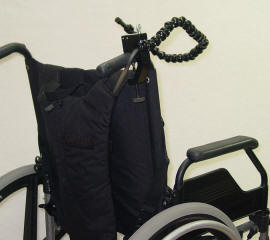 |
|
|
Hydration Backpack with Drinking Tube Positioning (i.e., for Manual Wheelchairs) |
Hydration Backpack with Drink Tube Positioning for Slide Track |
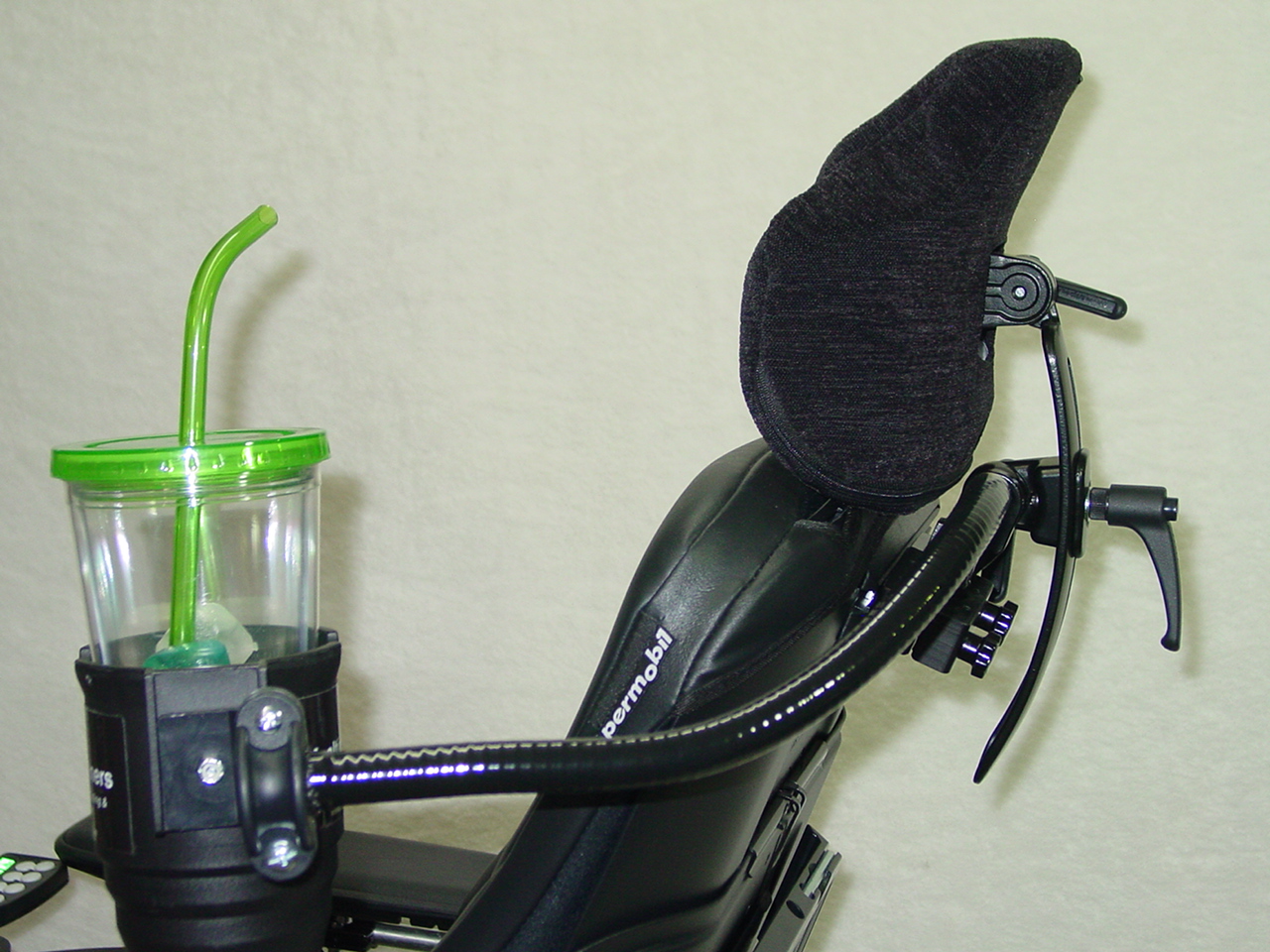 |
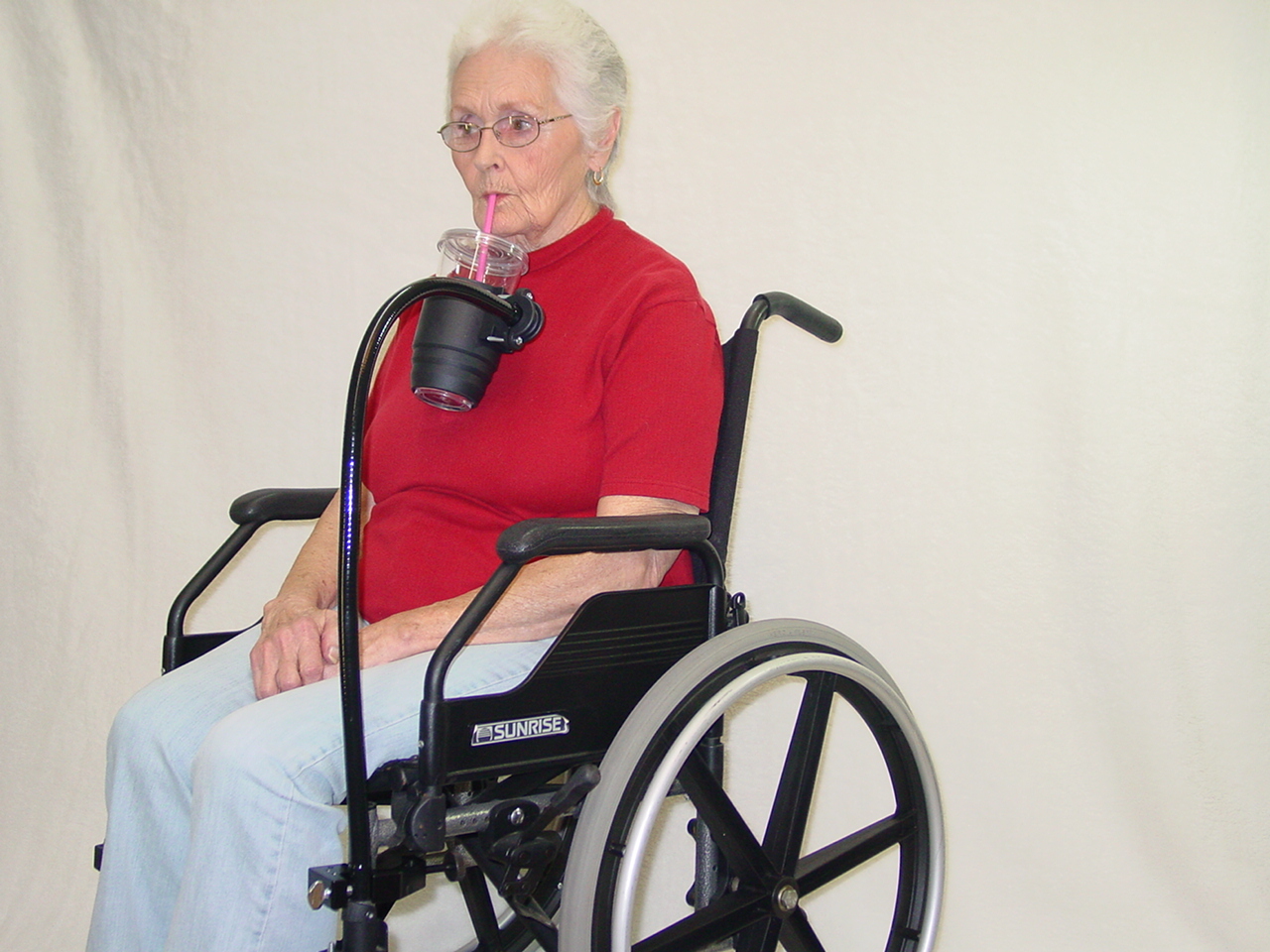 |
| Front Mounted Drinking System for Wheelchairs with Slide Track | Front Mounted Drinking System for Manual Wheelchairs |
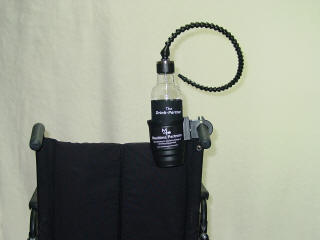 |
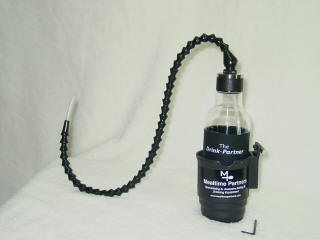 |
| Drink-Partner Mounted on a Wheelchair Handle | Drink-Partner for Slide Track |
| To view all of the Mealtime Partners drinking products, click here. Remember Mealtime Partners drinking products can be attached to powered wheelchairs with slide-tracks, manual wheelchairs with handles and/or tubular frames, or hospital beds with plastic or metal bed rails. For additional guidance about how to select the appropriate drinking system for your specific needs, click here. | |
This article is intended to address the hydration needs of students who are unable to pick up a cup or glass to provide them with a drink or take a drink from a water fountain.
Common practice in elementary schools is for students to be provided with either milk or juice in a carton or bottle at breakfast and lunch. Water, consumed by students during the day, is obtained from a water fountain. Bathroom breaks throughout the day are typically accompanied by a visit to the water fountain. A water fountain gives students a relatively small amount of liquid because when drinking from a water fountain, it is difficult to take more than a sip at a time. In high school, students are free to make their own decisions about what and when they will drink (though typically they are not allowed to drink during class). Many high schools have drink machines for students to purchase drinks. In the past, these machines contained soda. As awareness of good nutrition and the negative health impact of sugary drinks have increased, this practice has, for the most part, been discontinued. Now drink machines offer bottled water and sports drinks.
The question is: are students adequately hydrated to perform at their best when in school? In most cases the answer is no. Some schools are now recognizing this and taking action to change the situation. One school that I am aware of had a fund-raiser and used the money to buy every student a water bottle that they labeled with their name. At the beginning of each school day, students fill their bottles with water from the water fountains and keep them with them throughout the school day. They can drink whenever they want. The school Principal stated that anecdotal evidence showed that the students were calmer and performed better throughout the day. This is just an example of the potential benefits of drinking water. However, if you are unable to independently take a drink you may get very thirsty. If you are non-verbal, or have limited speech capability, the chances of under-hydration increase. Dehydration is known to foster the likelihood of bladder infections, constipation, headaches, increase spasticity, increase irritability, reduce the ability to concentrate, etc. Therefore, students with disabilities may be less able to apply themselves in school simply because they are under hydrated.
As with the students who were given water bottles, it is desirable to make water constantly available to students who are unable to take a drink independently. This is easily done for students who are able to drink through a straw. It is not so easy for those who cannot suck. This article will address the needs of those students who are able to drink through a straw.
For students who have good upper body control it is easy to sit a cup with a lid and straw on a desk, or to put it on the laptray of a wheelchair. The student can simply lean forward and sip from the straw. If, however, the student has some involuntary movement, the cup will need to be stabilized so that it won’t get knocked over. This can be accomplished by placing the cup in a cup holder, or by using a wide bottomed travel mug that is placed on a piece of Dycem. Also, some mugs with a non-slip bottom are available for purchase. Coffee mugs often have a tab that opens and closes to stop the liquid spilling. These are useful to hold straws at the desired angle for the user. Insert the straw into the hole and then gently snug the tab up against the straw to hold it in place.
For students who have a limited range of voluntary movement and who are unable to freely move toward and/or away from a straw, a drinking system that can be mounted appropriately for their needs should be used. Things that should be considered when selecting a drinking system are: the user’s ability to suck; the strength of their suction; their ability to move to a straw (the distance that the end of the straw can be away from their lips). Mealtime Partners, Inc. has developed several unique drinking systems to meet the specialized needs of individuals who have difficulties drinking independently from a traditional cup or glass. For more information about the available drinking systems, click here. For each drinking system available from Mealtime Partners, Inc., you will find a description of the unique characteristics and the profile of users who would benefit from using them.
Hopefully you have taken note that throughout this article, the intake of water has been discussed. Even if a student has a low caloric intake, and efforts are being made to increase it, making water available between meals is encouraged for proper hydration. The only exception to this rule is for those who must only consume thickened liquids. Thickening products change the taste and feel of drinks, and water often does not taste “right” when thickened. For those students, cranberry juice, diluted lemon juice or lemonade is recommended as it will help mask the taste of the thickening product.
| Did You Know? Did you know that Americans spend $40 billion on coffee, annually? People have been using coffee beans as a pick-me-up since the first millennium, and different varieties of coffee beans are popular with different cultures. The Arabica coffee bean is thought to be the first type of coffee bean to be cultivated, and now commands about 70% of the coffee market. One of the problems with a lot of coffees is that they tend to be bitter. One of the most expensive coffees in the world is “manufactured” to overcome the bitterness of regular coffee and produce a rich, smooth cup of coffee which costs $50 a cup! Black Ivory Coffee is produced in Thailand, at the Golden Triangle Asian Elephant Foundation. You might wonder why coffee is produced on an elephant refuge. The elephants are an essential part of the production process. Arabica coffee cherries (the fruit of the coffee tree) are picked when ripe from the coffee trees in the mountains around the refuge. The cherries are mixed with rice and other mashed fruit and fed to the elephants at the refuge. Because elephants are herbivorous, their digestive enzymes are able to break down the skin and pulp on the outside of the coffee cherry, and the protein in the pit, or coffee bean. The beans are excreted by the elephants, and collected out of the elephant dung. It takes approximately 70 pounds of coffee cherries to produce 2 pounds of coffee beans. The recovery rate for the coffee beans is low because the beans are crushed while the elephants eat the cherries or they are lost because the elephant dung is not found. Regardless, the coffee is extremely expensive to produce, and not everyone likes the idea of drinking coffee that is made from elephant excrement! What do you think, would you like a rich flavored cup of coffee or would you be grossed out by the thought of where it's been? |
Mealtime Partners Website Navigation:
Home | Dining | Drinking | All Products | Ordering | Training | Calendar | FAQ | Newsletters | Contact
Please send comments and suggestions to newsletters@mealtimepartners.com
Copyright © Mealtime Partners, Inc. 2017
All rights reserved.